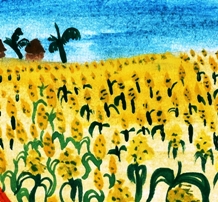Improving drought tolerance in sorghum for Africa

Sorghum is an important crop in the semi-arid regions of Africa where rainfall is limited and water-intensive crops such as maize cannot be grown. And although it isrelatively well-adapted to those regions, there is still a need to improve sorghum’s broad adaptability to these harsh environments, especially in light of the climate change that is affecting rainfall patterns in many parts of Africa.
The Sorghum Research Initiative (RI) mainly focuses on Mali, where sorghum-growing areas are large and rainfall is getting more and more limited, but the results will be readily applicable to other sorghum-growing areas. In addtion, and through the stay-green project, the scope has expanded to also encompass Burkina Faso, Ethiopia, Kenya, Niger and Sudan.
In Mali, the RI is testing two novel molecular breeding approaches (MARS [marker-assisted recurrent selection] and BCNAM [backcross nested association mapping]), that have good chances to quickly yield significant improvements in sorghum yield and adaptability:
Objectives
- To develop improved sorghum germplasm in Mali through MARS and BCNAM, that balance local agronomic and grain quality preferences with incorporation of well-characterised drought adaptations and desirable agronomic traits.
- In Phase II (2012–2014) of the stay-green project, to breed drought-tolerant sorghum for Burkina Faso, Ethiopia, Mali, Kenya, Niger and Sudan.
Launch of the Sorghum Research Initiative
More information
Visit our Sorghum InfoCentre, which has onward links to resources for researchers and an open-access book chapter on phenotyping sorghum for drought, as well as facts and figures and blogposts in everyday language.
Through our Product Catalogue, browse what we offer for sorghum.


